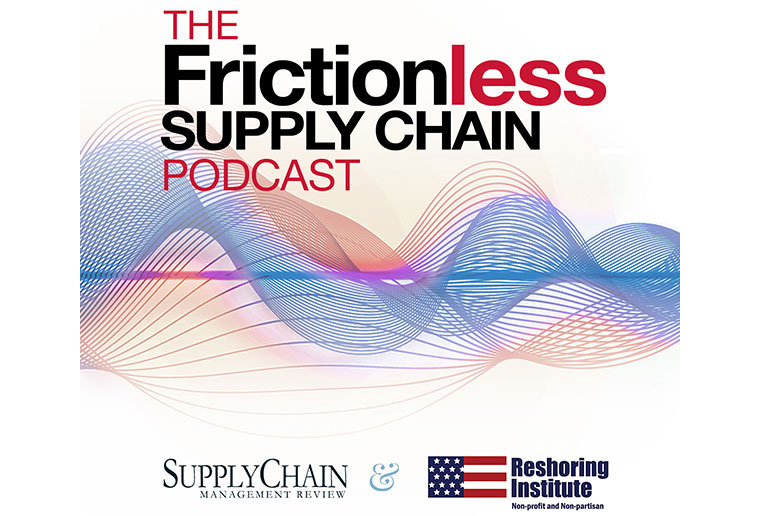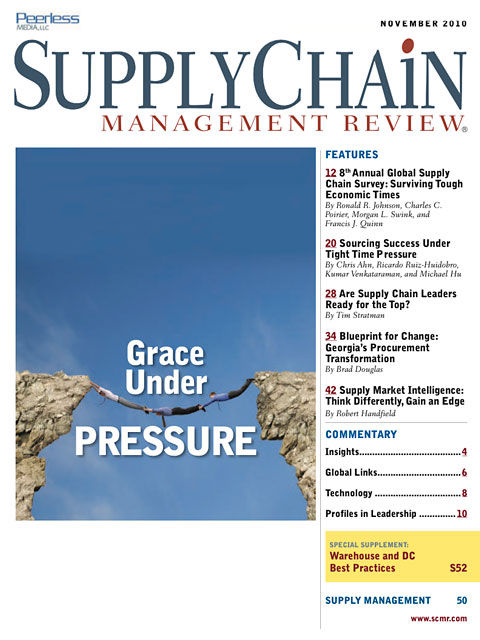Sorry, but your login has failed. Please recheck your login information and resubmit. If your subscription has expired, renew here.
November 2010
Grace under pressure. Anyone working as a supply chain professional over the last couple of years knows what that phrase is all about. With the economy only recently beginning to rouse itself from the doldrums, supply chain folks are still being asked to find “just a few more” areas where costs can be cut. For a while there, the cost-cutting pressures were unrelenting. But for the most part—as our Annual Global Survey of Supply Chain Progress in this issue confirms—the supply chain came through. One of the key findings from this year’s survey is that absent the supply chain’s ability to control costs and streamline operations, companies… Browse this issue archive.Need Help? Contact customer service 847-559-7581 More options
There is no question that during the recent economic downturn, companies turned to their supply chain and supply chain management (SCM) for help. Our 2010 Global Survey of Supply Chain Progress shows that, as might be expected, they did so with varying results in terms of the impacts on costs, revenues, and customer satisfaction. Compared to previous surveys, we saw a reported drop in the level of overall cost savings and revenue increases attributable to SCM initiatives. Importantly, there was a sharp difference in performance on these measures between firms considered to be supply chain leaders and the others—what we term the followers and the laggards. For example, the leaders reported twice as much revenue gain as the followers.
This year’s survey results further suggest that most firms are at or near the bottom of the economic trough and are slowly coming back to more favorable conditions. As expected, the leaders are rebounding faster than the followers and laggards. Yet from other information we have used to augment our conclusions from the survey results, we find that hiring is still conservative and the focus remains on cost reduction. Large companies remain conservative in their investments, foregoing new capital and concentrating on fixing existing capital. In that scenario, SCM becomes one of the major means to find cost improvement—right behind reductions in staff.
There appears to be a continuing emphasis on suppliers to help firms cope with adverse conditions. We see no lessening of that focus. Our survey showed clear evidence that companies relied more on suppliers to help with cost control, new product development and meeting customer demands this year. At the same time, there was continued expectation of finding better prices, or the buyer would shift its supply base. The key for suppliers was sustaining the most important customer base by offering help in both areas. This emphasis is expected to continue for at least another 12 months, as firms seek significant reductions to costs through pressure on suppliers and changes to the supply base.
 |
This complete article is available to subscribers
only. Click on Log In Now at the top of this article for full access. Or, Start your PLUS+ subscription for instant access. |
Not ready to subscribe, but need this article?
Buy the complete article now. Only $20.00. Instant PDF Download.
Access the complete issue of Supply Chain Management Review magazine featuring
this article including every word, chart and table exactly as it appeared in the magazine.
SC
MR
Sorry, but your login has failed. Please recheck your login information and resubmit. If your subscription has expired, renew here.
November 2010
Grace under pressure. Anyone working as a supply chain professional over the last couple of years knows what that phrase is all about. With the economy only recently beginning to rouse itself from the doldrums, supply… Browse this issue archive. Download a PDF file of the November 2010 issue.
 |
Download Article PDF |
There is no question that during the recent economic downturn, companies turned to their supply chain and supply chain management (SCM) for help. Our 2010 Global Survey of Supply Chain Progress shows that, as might be expected, they did so with varying results in terms of the impacts on costs, revenues, and customer satisfaction. Compared to previous surveys, we saw a reported drop in the level of overall cost savings and revenue increases attributable to SCM initiatives. Importantly, there was a sharp difference in performance on these measures between firms considered to be supply chain leaders and the others—what we term the followers and the laggards. For example, the leaders reported twice as much revenue gain as the followers.
This year’s survey results further suggest that most firms are at or near the bottom of the economic trough and are slowly coming back to more favorable conditions. As expected, the leaders are rebounding faster than the followers and laggards. Yet from other information we have used to augment our conclusions from the survey results, we find that hiring is still conservative and the focus remains on cost reduction. Large companies remain conservative in their investments, foregoing new capital and concentrating on fixing existing capital. In that scenario, SCM becomes one of the major means to find cost improvement—right behind reductions in staff.
There appears to be a continuing emphasis on suppliers to help firms cope with adverse conditions. We see no lessening of that focus. Our survey showed clear evidence that companies relied more on suppliers to help with cost control, new product development and meeting customer demands this year. At the same time, there was continued expectation of finding better prices, or the buyer would shift its supply base. The key for suppliers was sustaining the most important customer base by offering help in both areas. This emphasis is expected to continue for at least another 12 months, as firms seek significant reductions to costs through pressure on suppliers and changes to the supply base.
 |
SUBSCRIBERS: Click here to download PDF of the full article. |
SC
MR

Latest Supply Chain News
- Tips for CIOs to overcome technology talent acquisition troubles
- There is still work to do to achieve supply chain stability
- Blooming success: The vital role of S&OE in nurturing global supply chains
- Supply chain salaries, job satisfaction on the rise
- How one small part held up shipments of thousands of autos
- More News
Latest Podcast

 Explore
Explore
Latest Supply Chain News
- Tips for CIOs to overcome technology talent acquisition troubles
- There is still work to do to achieve supply chain stability
- Blooming success: The vital role of S&OE in nurturing global supply chains
- Supply chain salaries, job satisfaction on the rise
- How one small part held up shipments of thousands of autos
- Investor expectations influencing supply chain decision-making
- More latest news
Latest Resources

Subscribe

Supply Chain Management Review delivers the best industry content.

Editors’ Picks





